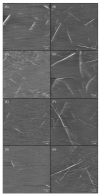Influence of Urea and Dimethyl Sulfoxide on K-Peptide Fibrillation
- PMID: 35328447
- PMCID: PMC8949822
- DOI: 10.3390/ijms23063027
Influence of Urea and Dimethyl Sulfoxide on K-Peptide Fibrillation
Abstract
Protein fibrillation leads to formation of amyloids-linear aggregates that are hallmarks of many serious diseases, including Alzheimer's and Parkinson's diseases. In this work, we investigate the fibrillation of a short peptide (K-peptide) from the amyloidogenic core of hen egg white lysozyme in the presence of dimethyl sulfoxide or urea. During the studies, a variety of spectroscopic methods were used: fluorescence spectroscopy and the Thioflavin T assay, circular dichroism, Fourier-transform infrared spectroscopy, optical density measurements, dynamic light scattering and intrinsic fluorescence. Additionally, the presence of amyloids was confirmed by atomic force microscopy. The obtained results show that the K-peptide is highly prone to form fibrillar aggregates. The measurements also confirm the weak impact of dimethyl sulfoxide on peptide fibrillation and distinct influence of urea. We believe that the K-peptide has higher amyloidogenic propensity than the whole protein, i.e., hen egg white lysozyme, most likely due to the lack of the first step of amyloidogenesis-partial unfolding of the native structure. Urea influences the second step of K-peptide amyloidogenesis, i.e., folding into amyloids.
Keywords: K-peptide; amyloids; dimethyl sulfoxide; fibrillation; hen egg white lysozyme; urea.
Conflict of interest statement
The authors declare no conflict of interest.
Figures






Similar articles
-
Insights into Kinetics of Agitation-Induced Aggregation of Hen Lysozyme under Heat and Acidic Conditions from Various Spectroscopic Methods.PLoS One. 2015 Nov 16;10(11):e0142095. doi: 10.1371/journal.pone.0142095. eCollection 2015. PLoS One. 2015. PMID: 26571264 Free PMC article.
-
Investigating the effects of sodium dodecyl sulfate on the aggregative behavior of hen egg-white lysozyme at acidic pH.Colloids Surf B Biointerfaces. 2010 Nov 1;81(1):141-51. doi: 10.1016/j.colsurfb.2010.07.001. Epub 2010 Jul 31. Colloids Surf B Biointerfaces. 2010. PMID: 20674294
-
Amyloid fibril formation in the presence of water structure-affecting solutes.Biophys Chem. 2019 Nov;254:106265. doi: 10.1016/j.bpc.2019.106265. Epub 2019 Sep 12. Biophys Chem. 2019. PMID: 31669866
-
A comparative study on the aggregating effects of guanidine thiocyanate, guanidine hydrochloride and urea on lysozyme aggregation.Biochem Biophys Res Commun. 2014 Aug 8;450(4):1339-44. doi: 10.1016/j.bbrc.2014.06.133. Epub 2014 Jul 5. Biochem Biophys Res Commun. 2014. PMID: 25003319
-
Promotion Effect of Succinimide on Amyloid Fibrillation of Hen Egg-White Lysozyme.J Phys Chem B. 2019 Sep 26;123(38):8057-8064. doi: 10.1021/acs.jpcb.9b06958. Epub 2019 Sep 12. J Phys Chem B. 2019. PMID: 31478670
References
MeSH terms
Substances
Grants and funding
LinkOut - more resources
Full Text Sources

